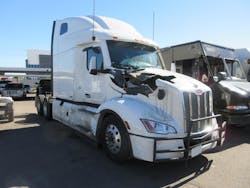Runaway rubber wrecking balls: How proper pre-trips stop wheel-offs
Trucking safety watchdog Rob Carpenter’s LinkedIn feed is littered with dash cam videos that illustrate just how dangerous trucking can be, from pants-soiling near-misses to violent tractor-trailer collisions. So many of these usually avoidable accidents pop up on my social media feeds that I’ve become desensitized. Still, there was one posted in June by Carpenter, VP of managed services at Trucksafe Consulting, that gave me pause.
The dash cam video, which Carpenter found on a Reddit driver forum, was taken from a newer Peterbilt Model 579 driving down a dusty desert highway in the right lane. Another semi passes on the left, clearly going much faster. As the passing tractor-trailer gets about 20 feet ahead, its right rear trailer dual wheel wobbles loose and slides across the Pete’s bow with plenty of room to spare. The dually would have harmlessly rolled through the barren terrain if not for a gentle dune that redirected the runaway tire up in the air like a superball. What goes up must come down, and nine seconds after breaking free of a trailer axle, this wheel forcefully landed on the Pete’s hood on the passenger side.
Watch the video here.
Now look at the damage, which was provided by the body shop estimator, Travis Hetherington, who initially received the damaged truck. The windshield, hood, and side body were destroyed, with damage to the engine as well. The initial estimate was several tens of thousands of dollars, though according to Hetherington, the operator chose to tow the truck to another body shop.
One way to look at this is that it’s a miracle the Peterbilt driver is alive. The dually landing just a foot or two over was the difference between life and death. But that driver’s guardian angel wouldn’t have had to get off his cloud if the other trucker had properly performed the pre-trip inspection on that trailer, and before that, proper maintenance was done on that wheel-end.
Without all the details, it’s really hard to know who in the trailer’s chain of custody was most negligent, but ultimately the driver is responsible. You can imagine all sorts of excuses for why this specific incident happened, but you would need a really vivid imagination to concoct a plausible story for why this continues to be an issue across the industry.
Carpenter said he regularly receives several of these types of videos.
“Incidents like these are becoming more common it seems,” he told Fleet Maintenance. “The frequency reinforces the need for rigorous and regular wheel and tire inspections.
“The fact that these incidents still occur suggests that there is a widespread issue with either the thoroughness of inspections or the consistency of maintenance practices across the industry,” Carpenter continued.
He did note that more people have dash cams, so more wheel-off events are seen now than in the past.
Frequent flying off
“Most fleets are well aware of the potential for wheel-end component failure, though I think videos and statistics do tend to make them more real,” commented Roger Maye, Director of Technical Service at ConMet, a supplier of wheel components and trailer technology.
Without hard data, it’s nigh impossible to know if these accidents are increasing or decreasing. The government does not track them.
But should they start?
“Absolutely, wheel-offs should be tracked by a governmental body,” Carpenter asserted. “Having official data would help quantify the extent of the problem and drive industry-wide improvement.”
Dave Walters, manager of warranty and field service at Alcoa, once called the frequency of wheel-offs “the darkest secret in our industry.”
According to MEA Forensics, upwards of 50,000 wheel-off events occur in North America every year.
Check out some of our other wheel-off coverage
· June 2018: Maintenance practices to prevent commercial vehicle heavy duty truck wheel-off conditions | Fleet Maintenance
· February 2020: Taking the extra step to prevent wheel-offs | Fleet Maintenance
· April 2022: Tethering device puts end to wheel-off accidents, inventor says | Fleet Maintenance
· April 2022: Mock trial demos depth of liability | Fleet Maintenance
· June 2024: Proactive approach to wheel-end health | Fleet Maintenance
· August 2024: In-house shop strategies to stop wheel-offs | Fleet Maintenance
To be fair, the wheels came off the government long ago, so don’t count on this being a priority for them. But it should be for every fleet, every technician, and every trucker who is responsible for the maintenance and safe operation of commercial vehicles. Even a pickup’s loose wheel can cause serious damage.
And while Maye, who has been with ConMet since the 1970s, estimated most fleets know the risks of poor wheel maintenance, not every person does their best to mitigate those risks.
“People tend to get complacent and take shortcuts,” Maye said. “Pre-trip and PM inspections are no exception to this. Fortunately, both the driver and the technician inspection requirements are very simple. Discipline is the key to making both of them work for you.”
Proper pre-trip inspections
Pre-trips are the last line of defense against wheel-offs, so let’s look at what drivers need to know.
The first thing is that missing even the tiniest problem today could kill someone tomorrow.
“Every component, no matter how small, plays a huge role in the overall safety of the vehicle,” Carpenter said. “Inspections at the frontline by drivers and their ability to communicate those defects via a DVIR to the fleet is crucial in our industry.”
It’s also mandatory. Todd DiMascio, sr. director of global sales at STEMCO, noted that Federal law 396.11 requires drivers to conduct pre-trip and post-trip inspections.
“If they do the vehicle inspection daily, this helps minimize wheel-related issues and equipment issues,” he said.
Poorly lubricated bearings and other wheel-end issues worsen over time due to friction; typically it’s not a situation where one day the wheel end is perfect and the next it is skipping down the highway. Proper inspections should provide enough lead time to remedy underlying issues before this happens.
“Pre-trip, post-trip, and in-route inspections can often expose symptoms of problems before they become big problems,” Maye said. “If the axle is equipped with ABS, warning lights can activate because of issues like excessive wheel-bearing endplay, which should give a driver a chance to react before a failure."
Drivers should also check the oil lube level in the hub caps, and identify any lubricant leaks on the hub cap area and brake side, DiMascio said.
“They need to look for obvious seal leaks and loose fasteners – rusty streaks on wheels are a good indicator of loose lug nuts,” noted Nick Tosie, ConMet’s national service group director. “They should also check the level and condition of hub lubricant, which is easy to do on oil bath hubs.”
He added the presence of a seal leak or if during the lube inspection, water, metal flakes, and/or discoloration is detected, service is needed.
Hub temperature should also be determined post-trip.
“If one hub is warmer than the others, it can indicate an issue that needs to be addressed immediately,” Tosie warned.
How hot is too hot?
“Normal operating temp in a wheel end is 60-80 Degrees F higher than ambient outside temperature,” DiMascio explained. “For example, the hub temperature would be 160-180 degrees F on a 100-degree F day.”
Anything above normal would hint at a problem. It’s important to note that in addition to wheel-offs, thermal events, where the wheel catches fire, are also a huge safety hazard. A tire’s rubber compounds start to break down at 250 degrees F, explained Phil Arnold, a retired product engineer with Michelin North America. Fires can start at 500 degrees F.
Read more: How wheel-end monitoring puts the brakes on thermal events
To see if the wheel end isn’t too hot, you can use your hand, though, on a Texas summer day, you may want to use an infrared laser thermometer gun. They start at around $20-30.
The key is to log anything suspicious on the DVIR. Carpenter advised using an electronic version for better tracking and transparency. Electronic DVIRs can also ensure proper signatures are on defective DVIRs and send alerts to stakeholders in the fleet so they can take action.
“If something doesn’t look right, get the shop to look at it as soon as possible,” Tosie said. “Pre-trips need to be an every day, every-trip occurrence. It must be ingrained in the culture of the fleet. Most catastrophic failures we see could have been visually spotted and addressed with a pre-trip inspection. Often, by the time it gets to the point of failure, it wasn’t just missed on one pre-trip inspection, but several.”
About the Author

John Hitch
Editor-in-chief, Fleet Maintenance
John Hitch is the award-winning editor-in-chief of Fleet Maintenance, where his mission is to provide maintenance leaders and technicians with the the latest information on tools, strategies, and best practices to keep their fleets' commercial vehicles moving.
He is based out of Cleveland, Ohio, and has worked in the B2B journalism space for more than a decade. Hitch was previously senior editor for FleetOwner and before that was technology editor for IndustryWeek and and managing editor of New Equipment Digest.
Hitch graduated from Kent State University and was editor of the student magazine The Burr in 2009.
The former sonar technician served honorably aboard the fast-attack submarine USS Oklahoma City (SSN-723), where he participated in counter-drug ops, an under-ice expedition, and other missions he's not allowed to talk about for several more decades.

